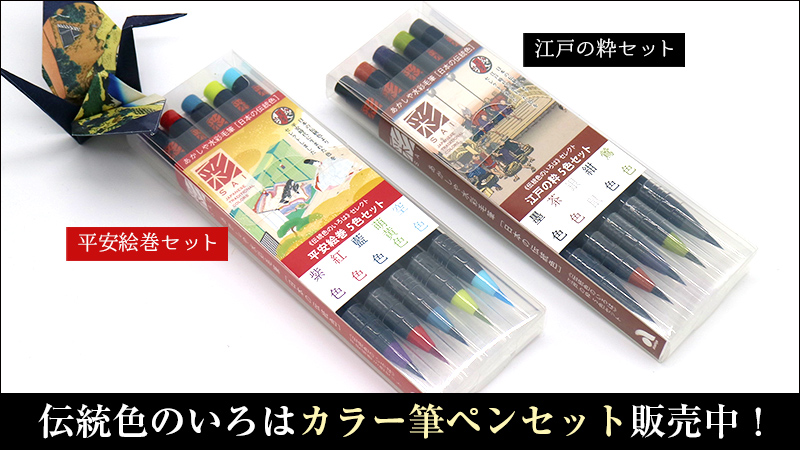| 色の名前Japan Color Name | 退紅(あらぞめ) |
|---|---|
| ローマ字Romanized | Arazome |
| RGB | R:238 G:201 B:209 |
| CMYK | C:00 M:25 Y:06 K:07 |
| Web カラーHex triplet | |
| 誕辰色 | 11月15日 |
色の説明
退紅(あらぞめ)とは、ごく淡い紅色のことです。平安時代から伝わる紅花染めの色名で、「あらそめ」とも読まれました。色名の「退」は「褪 」と同義であり、「褪 めた紅」の意味です。ただし、ここでいう「褪めた」とは退色した色ではなく、もともと淡い紅色のことでした。
『退紅 』は、許し色の基準とされた『一斤染 』よりわずかに薄く、『桜色』より濃い紅花染めの色とされ、書物によっては「洗染」「荒染」「粗染」などの名称で記されていますが、いずれも同じ色を指しました。また、『装束色彙 ※1』では、「薄紅、退紅に同じ。」との記述があり、『薄紅 』と『退紅 』を同じ色とする説もあります。
※1:「装束色彙」江戸中期に書かれた有職故実の書籍
染色法については、「延喜縫殿式 」に「帛(きぬ)一疋 に紅花小八両、酢一合、藁 半囲、薪三十斤を用いる」と記されており、酢を媒染剤として用いることで淡い紅色が得られていました。また、紅花の搾り滓 でも染められていたとも伝えられています。
※一疋 は二反 分の長さで22m前後。
※囲 は草の束を数える単位。
※一斤は約600g。両は1/16斤で約37.3g。
「延喜弾正台式』では、『退紅 』は官人や従者、雑役の者の服色として定められており、身分の低い者が着用した場合は「たいこう」と訓み区別していました。江戸後期の有職故実書「貞丈雑記 」にも「退紅と云うも卑しい者の服である」との記述があります。

-読み:あらぞめ-
関連する色の紹介
[Explanation of a color]
Arazome (退紅) is a very pale shade of red. It is a traditional color name derived from benibana (紅花, safflower) dyeing, dating back to the Heian period, and was also pronounced as arasome. The character "退" (tai) is synonymous with "褪" (tai), meaning "faded red." However, in this context, "faded" does not refer to a color that has lost its vibrancy over time, but rather to a naturally light shade of red.
Arazome was considered a shade slightly lighter than Ikkin-zome (一斤染), which was the standard reference for permitted colors, and darker than Sakurairo (桜色, cherry blossom color). Various texts refer to it by different names, such as Senzome (洗染, washed dye), Arazome (荒染, rough dye), and Sozome (粗染, coarse dye), all of which describe the same color. Additionally, Shouzoku Shokui (装束色彙) states that "薄紅 (Usukurenai, light crimson) and 退紅 (Arazome) are the same," suggesting that some sources regarded them as identical shades.
Regarding the dyeing method, Engi Nuidenshiki (延喜縫殿式) records that "one hiki (疋) of silk requires eight ryō (両) of safflower, one gō (合) of vinegar, half a bundle of straw, and thirty kin (斤) of firewood" to achieve this shade. Vinegar was used as a mordant to bring out the pale red color. It is also said that the residue of safflower extraction was sometimes used for dyeing.
In Engi Danzyoudaishiki (延喜弾正台式), Arazome was designated as the clothing color for officials, attendants, and menial workers. When worn by individuals of lower social status, it was pronounced as Taikou (たいこう) to distinguish it from its standard usage. The Teijou Zakki (貞丈雑記), a late Edo-period text on court customs, also notes that "退紅 is the clothing of the lowly," indicating its association with the attire of lower-ranking individuals.
-read:Arazome-
参考書籍
- 長崎盛輝『新版 日本の伝統色 その色名と色調』青幻舎 ISBN-10:4861520711
- 吉岡幸雄『日本の色辞典』紫紅社 ISBN-10:4879405493
- 内田 広由紀『定本 和の色事典』視覚デザイン研究所 ISBN-10:4881082035
注意事項
表示されている色(RGB値)は色の名前に対するおおよそものです。色名によっては広範囲の色を指す場合や文献・書籍等によっては解釈が異なる場合もありますのでご了承ください。 ご利用の環境によっては、色が適切に表示されていない場合があります。
印刷などに伝統色を利用したい場合は、DICグラフィックス株式会社から発売されている日本の伝統色シリーズがオススメです。
Pinterestでシェアする際にご利用ください。
サイト運営者からのお願い
このサイトが気に入った、役に立ったと思われた方は、Amazon・楽天で買い物をする際はぜひ下記のバナーをタップしてからお買い物をお願いいたします。
こちらからお買い物をしていただきますと、価格の1%相当のポイントがサイトに入ります。もちろんその分、高くなるようなことはありません。
いただいたポイントは今後のサイト運営のための書籍代や運営費、モチベーションにつながりますので、ご協力いただけますと嬉しいです。

 DIC 日本の伝統色 第9版
DIC 日本の伝統色 第9版



